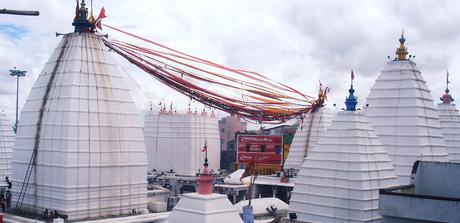
Baidyanath Jyotirlinga Temple also known as Baba Baidyanath Dham is considered as one of the 12 Jyotirlingas in India. It is a highly auspicious pilgrimage center among the Hindus and draws devotees from all over the country every year.
Keep scrolling to know more about Baidyanath Jyotirlinga temple and its history.
Contents
Location
Baidyanath Dham is located in Deoghar in the Santhal Paraganas division of Jharkhand. Deoghar is a Hindi word which literally means 'Home of Gods' where 'Deo' means 'God' and 'Ghar' means 'Home'.
Located at a distance of 248 KM from the capital city of Ranchi and 325 KM from the nearest metro city Kolkata in West Bengal, Baidyanath Jyotirlinga is an important religious tourism destination in Jharkhand.
Why Baba Baidyanath Temple Is Famous?
The place has a remarkable history attached and therefore finds mention in several ancient scriptures as well as in the modern-day saga. Apart from being one of the 12 Jyotirlinga, it is also considered as one of the holy 108 Shakti Peethas in the Hindu mythology.
Jyotirlinga
A Jyotirlinga or Jyotirlingam is a spiritual representation of Lord Shiva and it is believed that a Jyotirlinga is established in every place where Lord Shiva made an appearance on Earth.
However, originally it was believed to have 64 Jyotirlingas but only 12 of them are considered highly auspicious. Each of the 12 Jyotirlingas symbolizes a different manifestation of Lord Shiva.
The History of Baba Baidyanath
The story of Baidyanath temple takes us back to the Treta Yuga. According to the popular Hindu belief, Ravana the King of Lanka was a great devotee of Lord Shiva. Once he felt that his capital would be incomplete and under the constant threat of enemies unless Lord Shiva decides to stay there forever. So, he went to the Himalayas to impress the Lord and started offering his heads one after another.
When he was about to cut off his 10th head, Lord Shiva descended on Earth impressed by his devotee. He then cured the wounded Ravana and granted him a boon.
Temples in Jharkhand not only provide its devotees or tourists with a composed and peaceful environment with divine aura but also let them learn a lot about the history of their respective places. Jharkhand is a home to hundreds of natural as well as historical wonders. pic.twitter.com/P6RRDRI4T6
- Jharkhand Tourism (@VisitJharkhand) July 6, 2020
Ravana requested Lord Shiva to allow him to take the Shivalinga back to Lanka with him to which the Lord agreed but on one condition. Lord Shiva warned Ravana that he cannot keep the Shivalinga on the ground until he reaches Lanka and if he does so it will get fixed to the ground and he will never be able to uproot it. Ravana agreed to the condition and began his journey.
All the other God and Goddess were not happy with the decision because they knew, if Shiva went to Lanka with Ravana, then he would become invincible and his evil deeds would threaten the world. They met Lord Vishnu and asked him to stop Ravana, the demon king from taking the Shivalinga to Lanka.
Lord Vishnu asked Lord Varun, the Ocean God to enter the stomach of Ravana at the time he performs Aachamanam during the Sandhya Vandana, the evening prayer. Aachamanam is a process of purifying by sipping drops of water while reciting the 21 names of Vishnu.
When Ravana reached Deoghar, it was almost evening so he decided to perform his evening prayers. As asked, Lord Varun entered his stomach during the Aachamanam and Ravana felt an urgent need to release himself. He gave the Shivalinga to a milkman and asked him to take care of the lingam until he comes back.
To utter surprise, the more Ravana released himself, the more he felt the urge. He took a long time to come back and the impatient milkman kept the shiva linga on the ground and went away.
When Ravana finally returned he saw that the Shivalinga was fixed on the ground. He tried a lot to uproot it but failed miserably. Ravana damaged the Shivalinga in the process. He understood that the milkman was Lord Vishnu who pranked him and left the place in anger. Later, God and Goddess came down from heaven and established the Shivalinga.
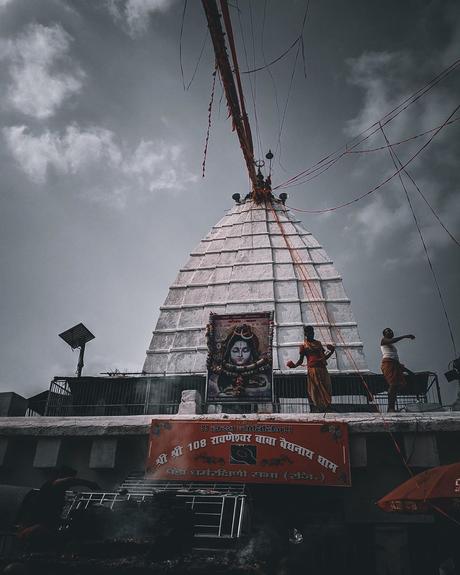 Instagram Handle: drklickz
Instagram Handle: drklickz The temple complex has a pond which is considered the place where Ravana released himself. It is said that as Lord Shiva cured Ravana and acted as a doctor, he is referred to as 'Vaidhya', a Sanskrit word meaning 'physician' and that's how the temple derives its name.
Also, as Shiva granted the wish to Ravana, therefore the Shiva linga is called 'Kamana Linga' as Kamana means 'Desire'.
Shakti Peetha
Baidyanath Dham is the only place in India which is both a Jyotirlinga and a Shakti Peetha. It is believed that the heart of Sati fell at Baidyanath Dham when Lord Vishnu used the Sudarshana Chakra, to cut Sati's corpse in order to stop Shiva's destruction.
The temple of Lord Parvati is located adjacent to the main temple of Lord Shiva, tied up with red threads to show the unity between them.
Structure Of The Temple
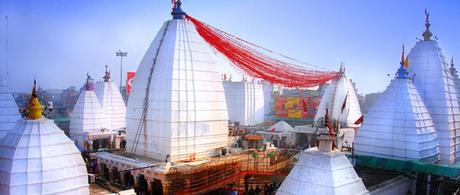
The temple is divided into three parts, the entrance, the middle part, and the main temple. The 72 feet high temple faces the east and resembles a lotus. On top of the temple are three gold vessels that were donated by the Maharaja of Gidhaur, Raja Puran Singh. Other than the vessels is a 'Punchsula', which is five knives in a Trident shape, and an eight-petalled lotus jewel, known as Chandrakanta Mani.
 Baba Baidyanath Dham Shivalinga
Baba Baidyanath Dham ShivalingaInstagram Handle: dumakakhabr
The Shivalingam is approx 5 inches in diameter, 4 inches in height, and is broken at the top. The temple complex has a total of 21 temples other than the main Shiva temple, dedicated to Maa Parvathi, Maa Kali, Maa Jagat Janani, Kal Bhairav, and Lakshminarayan.
Who Built Baidyanath Temple And When?
It is believed that the Baidyanath temple was constructed by Lord Vishwakarma, the divine architect. Certain parts of the front portion of the temple are said to have been built by Puran Mal, an ancestor of the Maharaja of Giddhour, in 1596. However, the name of the builder of the temple is not known.
Shravani Mela and Kanwar Yatra
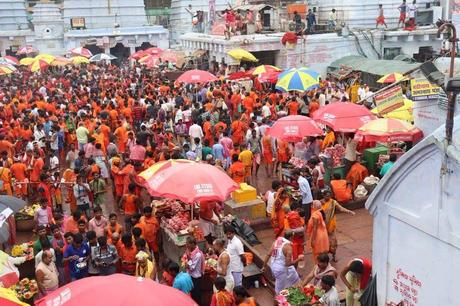 Shravani Mela
Shravani MelaInstagram Handle: currentaffairsupdated
Shravani Mela is a month-long religious fair that is organized in the holy month of Shravan i.e between July and August. Millions of pilgrims from all over the country visit Baba Baidyanath Dham every year to offer holy water of Ganges to the deity collected from Sultanganj, located in Bhagalpur district of Bihar, almost 108 km from Deoghar.
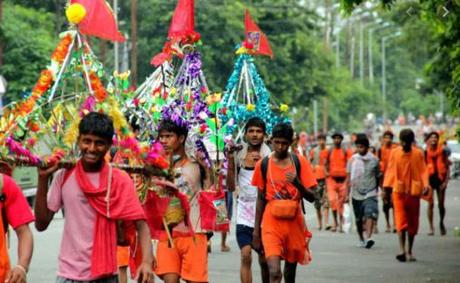 Kanwar Yatra
Kanwar YatraPic Credit: Zee News
The devotees known as Kanwarias, carry the holy water from Sultanganj to Baidyanath Dham by covering 108 KM barefoot without stopping for even once. The journey is known as Kanwar Yatra. The pilgrims chant the mantra of 'Bol Bam' in the entire journey and are dressed in saffron clothes.
Timings Of Baba Baidyanath Temple
The temple door opens at 4:00 AM and remains open till 3:30 PM. After which the doors are closed. In the evening the door is again opened for the devotees at 6:00 PM and closes at 9:00 PM. However, during any special occasion, the temple remains open beyond the closing hours.
Nearest Railway Station To Badiyanath Temple
Jasidih Junction (Station Code: JSME), located at a distance of 8 KM is the nearest railway station to Baidyanath Dham.
Nearest Airport To Badiyanath Temple
The nearest airport to Baba Baidyanath Dham is Birsa Munda Airport, Ranchi located at a distance of 253 KM.
The nearest International Airport is Netaji Subhas Chandra International Airport, Kolkata located at a distance of 324 KM.
How To Reach Baidyanath Temple By Train?
Board a train to Jasidih Junction (Station Code: JSME), the nearest railway Junction to Baidyanath Temple, Jasidih is well connected by trains with all the major cities of India. Check out the list of trains from New Delhi, Mumbai, and Kolkata to Jasidih.
List Of Trains From Different Destinations To Jasidih
How To Reach Baidyanath Temple From Jasidih Junction?
After reaching Jasidih take a DMU train up to Baidyanath Railway Station (Station Code: BDME) or one can also book a cab or auto to the temple from Jasidih. Buses are available too.
The distance of Baba Badiyanath Temple from Jasidih is 8KM which can be easily covered in half an hour.
How To Reach Baidyanath Temple By Air?
Book a flight to Birsa Munda Airport, Ranchi or Netaji Subhas Chandra Bose International Airport, Kolkata. Then board a train or book a cab to cover the rest of the journey. Bus services are available from Ranchi to Deoghar but not from Kolkata.
Where To Stay While Visiting Baidyanath Temple?
Uma Bhawan is located within the complex of the temple which has rooms as well as dormitories equipped with all facilities. The booking can be done by contacting Baba Mandir Office.
Baba Mandir Office, Deoghar - Phone No. 06432-232295
Most of the hotels are in Tower Chowk Road in Deoghar, located within 1 KM from the main temple.
Other Places To Visit In Deoghar
- Nandan Pahar
- Tapovan Caves and Hills
- Naulakha Temple
- Basukinath Temple
- Satsang Ashram

